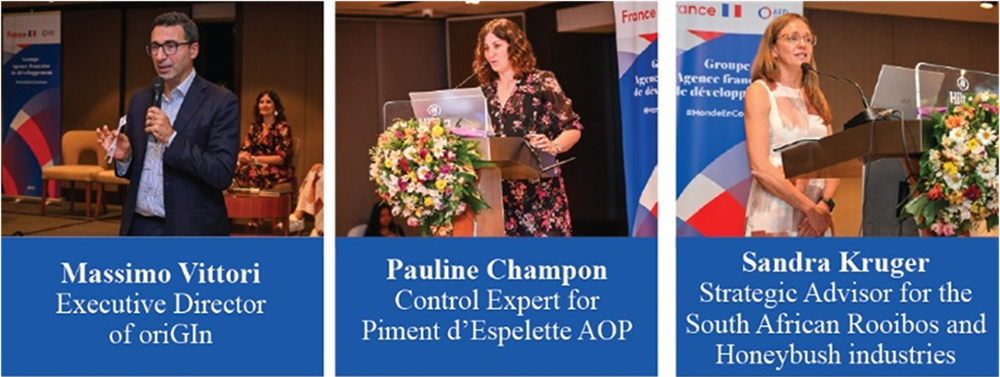
As Sri Lanka explores new ways to enhance the value of its agricultural and artisanal heritage, Geographical Indications (GIs) are emerging as a promising pathway. GIs are distinctive signs that identify products whose quality and reputation are intrinsically linked to their place of origin. More than a label, they are powerful tools for sustainable rural development, market competitiveness and heritage safeguarding. Many world-renowned products including French Champagne, Greek Feta, and Darjeeling Tea hold Geographical Indication status.
Recent progress, from the EU registration of Ceylon Cinnamon to the establishment of a national GI framework and the ongoing application for Ceylon Tea, signals a growing commitment to origin-based strategies in Sri Lanka. These steps mark the beginning of a new chapter for Sri Lankan products, one that strengthens their identity and appeal in international markets. Reflecting on this shift, Mr. Raaj Obeyesekere, Chairman of the Sri Lanka Tea Board, underscores the transformative potential of GIs:
“The GI Status for Ceylon Tea is a powerful tool that protects origin identity, combats imitation, and positions Ceylon Tea at a premium in international markets. More importantly, it empowers our producers and brings long-term value to rural communities across the country”.
As the Ceylon Tea GI project supported by the French Development Agency (AFD) comes to an end, the Sri Lanka Tea Board (SLTB), in collaboration with the French International Research Center for Agricultural Development (CIRAD) and the Institute of Policy Studies (IPS), brought together international experts for a dedicated conference on Geographical Indications organized under the patronage of the Embassy of France to Sri Lanka and the Maldives. The event offered diverse perspectives and experiences, highlighting how GIs can unlock new opportunities for producers and drive sustainable economic growth.

GIs as a Guarantee of Quality and Traceability
Geographical Indications help define and enforce quality standards across entire value chains while ensuring full traceability of production and protecting against fraud, imitation, and misuse. As Massimo Vittori, Managing Director of oriGIn, an international GI association, explains, “Quality linked to a specific local tradition is codified in a product specification, which must be respected by all value chain actors and subject to control.” This reputation is “deeply rooted in their place of origin, often shaped by history and associated with added market value,” adds Dr. Delphine Marie-Vivien, Researcher in GI Law at CIRAD.
Pauline Champon, Control Expert for the Espelette Chili Pepper Syndicate, adds that “operators commit to clear production practices that meet consumer expectations” and that “the GI book of specifications is both a safeguard and a powerful tool against fraud.” In emerging sectors such as the South African Honeybush industry, Sandra Kruger, strategic advisor for South African Rooibos and Honeybush industries, notes that product specifications also “serve as an awareness-raising tool” for producers and new entrants, guiding the industry towards higher standards.
GI as a tool for collective action
Collective action is the backbone of any Geographical Indication. In Sri Lanka, the development of the Ceylon Tea book of specifications brought together more than 500 operators from across the value chain. “All operators’ voices can be heard,” emphasizes Champon, Espelette Chili Pepper representative. As Dr. Delphine Marie-Vivien explains, “Because GIs require coordination to define and manage the quality and reputation of the designated product, they naturally foster more inclusive forms of governance, ensuring that all actors in the value chain are represented.”
This collective force often materializes in the creation of an association responsible for representing the entire value chain. “The more inclusive such associations are, the more likely they are to effectively address the issues a GI might encounter,” says Vittori, the Managing Director of OriGIn. Kruger recalls that in the case of Honeybush, the initiative “galvanized diverse stakeholders” and built bridges between environmental, social, and economic priorities, demonstrating the unifying potential of GIs.

GI as a Marketing and Competitiveness Tool
Beyond governance and quality assurance, GIs can significantly enhance a product’s market position and, as CIRAD legal adviser points out, “serve as a powerful communication tool to promote the product.” “The fact that consumers can easily identify and trust products through a GI makes them a powerful market recognition tool,” explains Vittori, adding that this recognition can translate into higher prices and stronger market demand. Moreover, Marie-Vivien highlights that “action can be taken against illegal uses, ensuring that consumers can confidently access authentic products in the market.”
Kruger highlights another advantage: “GIs provide a contact point and governance mechanism for handling consumer, buyer, or client feedback.” However, Vittori, OriGIn Managing Director warns that this potential is only fully realized when “a combination of administrative enforcement by public authorities and private action by the GI association” is in place – without which a GI risks becoming inactive.
GIs as territorial development instrument
When well-managed, GIs can have far-reaching impacts beyond the product itself, generating “spill-over effects” across entire territories “by attracting investment in infrastructure, tourism, retail, and more,” notes Vittori from OriGIn. According to Dr. Delphine Marie-Vivien from CIRAD, “GIs also encourage producers to sustain their activities in the long term, providing them with a sustainable livelihood.”
The French village of Espelette illustrates this perfectly. “Thanks to the reputation of Espelette Chili Pepper, tourism flourished,” says Champon. A dedicated interpretation center and producer shops in the town center were established, creating jobs and revitalizing the local economy.
GIs also support sustainability and inclusivity. In the case of Rooibos and Honeybush, they “offer the opportunity to integrate critical sustainability objectives into the industry” and create space for “traditional knowledge holders” to contribute meaningfully, “It is an example of how a plant, a place, and an industry can be collectively valued, protected, and conserved through sustainable use” concludes Dilani Hirimuthugodage.
The key to success
Asked about the key ingredients for a successful Geographical Indication, all experts point to the same factors: a cohesive and inclusive value chain built on strong commitment, cooperation, and trust among actors. Dr. Marie-Vivien from CIRAD emphasizes, “The key to success lies in the willingness of value-chain actors to work together to protect the reputation of their product both by jointly defining the production rules and geographical area required to obtain the specific product, and by ensuring those rules are properly enforced.” At the same time, GIs are not static. They evolve over time in response to feedback, changing market conditions, and new challenges.
This flexibility is one of their greatest strengths. GIs are not only powerful tools to protect shared heritage and define quality standards – they are dynamic instruments that boost visibility, enhance market competitiveness, and drive sustainable development.
Conclusion – Strategic Path Forward for Sri Lanka
For Sri Lanka, this is just the beginning. As Dilani Hirimuthugodage, Research Economist at IPS points out, “Sri Lanka can enhance its GI system by adopting international best practices to streamline registration and implementation. Establishing a dedicated GI division within the National Intellectual Property Organization (NIPO), with clear guidelines and product classification by type, would improve accessibility and efficiency. A nationally recognized GI logo could aid product differentiation and consumer trust. Public access to the GI registry via an online platform would promote transparency. Interagency collaboration, through a GI Council including NIPO, Export Development Board, the Tea Board, the Spice Council, and producer groups would support coordinated policy implementation. Strengthening quality control and traceability via QR codes and blockchain through government extension services would further ensure authenticity.
Raising producer awareness of their role in GI governance is essential, as public understanding of GIs remains limited. Coordinated public-private educational campaigns should emphasize the economic, cultural, and legal value of GIs. Government support could include initiatives like a ‘One District, One GI Product’ program and targeted incentives such as concessional loans and tax benefits. Additionally, promoting GI-based tourism through tea tours, spice gardens, and handicraft trails can increase demand and consumer engagement.
Joint government and trade association efforts are needed to strengthen domestic and international GI marketing. Enhanced enforcement, including stricter penalties and improved market surveillance, is crucial. Capacity-building through public-private partnerships should focus on training producer groups in legal frameworks, branding, enforcement, and governance relating to GIs.
A robust legal framework, empowered producer governance, and strategic quality and marketing initiatives are vital to strengthening Sri Lanka’s GI system and unlocking its full potential for local producers and consumers.” concludes Dilani Hirimuthugodage.

Interviews conducted by Antoine Renaud, CIRAD Project Officer, with contributions from Dr. Delphine Marie-Vivien, Research in Law at CIRAD, Dilani Hirimuthugodage, Research Economist at IPS, Massimo Vittori, Executive Director of oriGIn (International Geographical Indications Network); Pauline Champon, Control Expert for Pimentd’ Espelette AOP; and Sandra Kruger, Strategic Advisor for the South African Rooibos and Honeybush industries.
